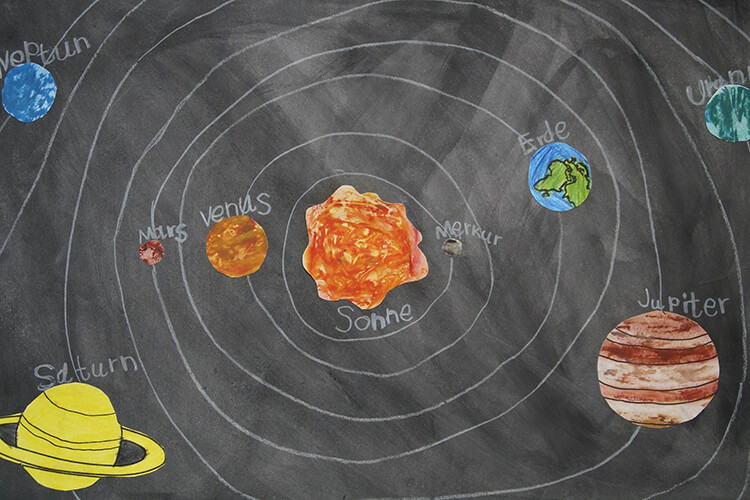 It is crucial that teachers make elementary school science fun.
It is crucial that teachers make elementary school science fun.
There are plenty of free online resources they can take advantage of when teaching science.
Here is a list of lesson ideas and resources.
Biology
1. Living vs. Nonliving Things
Have students study the characteristics of the living and nonliving things in their classroom. Afterward, have them complete an identification activity.
2. Parts of a Plant
Have students explore the different parts of a small, potted plant. Afterward, allow them to complete a labeling activity.
3. Plant Life Cycle
Have students watch and take notes on a video that illustrates each stage of a plant’s life cycle. Then, have them create a poster of a plant’s life cycle.
4. Parts of the Human Body
Have students explore and discuss the different parts of their bodies. Afterward, allow them to complete a labeling activity.
5. Five Senses
Have students engage in an interactive activity that will help them discover what their eyes, ears, nose, tongue, and hands do. Then, allow them to make an infographic that explains each of their five senses.
6. Organ Systems
Have students choose a particular organ system to explore. Then, have them watch one of several videos and write a short summary of what they learned.
7. Vertebrate vs. Invertebrate
Have students engage in an interactive activity that will help them identify the differences between vertebrate and invertebrate animals. Then, have them make visual flashcards of different vertebrate and invertebrate animals.
8. Animal Classification
Have students use infographics to explore the characteristics of mammals, reptiles, amphibians, birds, and fish. Then, have them create a poster showcasing the traits of a specific animal class.
9. Learn about Animals
Randomly pick an animal and assign to the student, or allow the student to pick their own animal. Have the students draw and color their animals along with writing about the animal. Where it lives, how big does it get, etc.
10. Animal Habitats
Have students look at captioned, visual slideshows that describe the characteristics of grassland, polar, desert, and mountain habitats. Then, have them write a short story set in one of those habitats.
11. Energy Flow
Allow students to engage in an interactive activity that will help them understand how energy flows from one organism to another. Then, have them write a short essay that describes the energy flows needed to create their favorite dish.
12. Herbivores, Carnivores & Omnivores
Have students participate in an interactive activity that will help them identify the traits of herbivores, carnivores, and omnivores. Then, have them create a visual chart that describes all three dietary categories.
13. Chicken Life Cycle
Have students watch and take notes on a video that depicts each stage of a chicken’s life cycle. Then, have them create a poster of a chicken’s life cycle.
14. Butterfly Life Cycle
Have students engage in a multimedia activity that showcases each stage of a butterfly’s life cycle. Then, have them create a diorama of a butterfly’s life cycle.
Conservation / Ecology
15. Water Cycle
Have students use an interactive diagram to pinpoint each stage of the water cycle. Then, have them create their own diagram of the water cycle.
16. The States of Matter
Allow students to explore the different states of matter using ice cubes, water, and steam. Afterward, they can play a states of matter game.
17. Reduce, Reuse, Recycle
Have students complete an interactive activity that will help them learn how to reduce, reuse, and recycle. Then, ask them to come up with ways they can reduce, reuse, and recycle at home and at school.
18. Renewable vs. Nonrenewable Resources
Have students watch a video that will help them identify the differences between renewable and nonrenewable resources. Then, have them discuss the renewable and nonrenewable resources they see being used in everyday life.
19. Types of Forests
Have students look at captioned, visual slideshows to identify the characteristics of rainforests and temperate forests. Then, have them create a diorama of their favorite type of forest.
20. Layers of the Rainforest
Have students explore an interactive diagram that showcases the various layers of a rainforest. Then, have them create a poster that shows each layer of a tropical rainforest.
Physics
21. Solar System
Have students take a virtual tour of the solar system so that they can learn about various astronomical objects. Then, have them build their own model of the solar system.
22. Potential vs. Kinetic Energy
Have students watch a video that explains the difference between potential and kinetic energy. Then, have them build a model rollercoaster that showcases the different forms of energy.
23. Chemical vs. Physical Changes
Have students complete a virtual lab that will help them make the distinction between physical and chemical changes.
24. Float or Sink
Have students complete a virtual lab that will help them understand why certain objects float or sink in water.
Earth Science
25. Types of Clouds
Have students explore and take notes on a detailed chart that describes the various types of clouds. Then, have them make a painting that features their favorite cloud types.
26. Salt vs. Fresh Water
Have students look at captioned, visual slideshows to identify the differences between saltwater (i.e., oceans) and freshwater habitats. Then have them create a mini-aquarium of an aquatic habitat of their choice.
27. Types of Weather
Have students watch a video that describes the different types of weather. Then, have them create a daily weather forecast chart.
28. Seasonal Change
Have students engage in an interactive activity that will help them understand how the position of the Earth from the Sun leads to seasonal change.
29. Types of Biomes
Have students watch a video that describes the different types of biomes. Then, have them create a poster of their favorite type of biome.
30. Geographic Features
Have students complete an online activity to learn about various types of landforms and waterways. Then, have them draw a picture of their favorite geographic feature.
31. The Earth’s Layers
Have students complete an interactive activity that illustrates the various layers within the Earth. Then, have them create a clay model of the Earth’s layers.
32. Types of Rocks
Have students complete a virtual lab so that they can classify igneous, metamorphic, and sedimentary rocks.
33. Volcanoes 101
Have students watch a video that explains the characteristics of volcanoes. Then, have them create a model volcano, using baking soda and vinegar.
33. Climate Change
Have students engage in an interactive activity that showcases how the Earth’s climate has changed over time.


